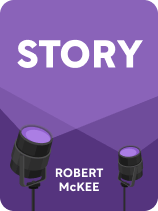

This article is an excerpt from the Shortform book guide to "Story" by Robert McKee. Shortform has the world's best summaries and analyses of books you should be reading.
Like this article? Sign up for a free trial here.
Why should a story outline take more time than the other steps in the writing process? Should you work forward or backward?
In his book Story, Robert McKee details what he believes to be the ideal writing process: Begin with an outline, flesh it out into a treatment, then polish it into a final script. McKee frames this as a process for screenwriters, but you could apply it to stories in any medium.
Let’s look at McKee’s advice for how to write a story outline.
How to Write a Story Outline
McKee’s first step in writing a story is to create an outline: a detailed description of every one of your story beats and value changes. This outline is solely a description of plot and intentionally lacks dialogue or screenplay-style description. Since you’re essentially writing your entire story in outline form, this step will take up the majority of your time.
In his recommendations for how to write a story outline, McKee says that you should outline many more scenes than you plan to end up using. The way to find the best ideas is to write as many of them as possible, then select the very best and throw the rest away.
(Shortform note: The reason that writing more scenes than you need gives you the best ideas is that judging your ideas as you write them inhibits the parts of your brain necessary for creativity. If you plan on only writing one scene, you’ll be constantly judging it to make sure it’s good. However, if you plan on writing more scenes than you need, you can focus on being creative and judge your ideas later.)
Keep writing compelling scenes, fleshing out the world of your story, until you find a climax that strikes you deeply on an emotional level. This climax will reveal to you what the theme of your story is: your story’s final change and the cause behind that change. Then, you can start building your story backward. Since every beat in your story should support the climax logically and thematically, the climax gives you the direction you need to start solidifying the scenes, sequences, and acts of your story.
Once you have a complete story, McKee recommends pitching it to a friend. Tell them the entire story, beat by beat. Keep fine-tuning your outline until you have a story that reliably delivers an emotional impact on your listeners. This way, you don’t waste time fleshing out a story that doesn’t work.
(Shortform note: In On Writing, Stephen King recommends picking a single close friend or family member who will be the first to hear your story every time. According to King, when you imagine how this person will react to your story while you’re writing, you’ll be more likely to write something that resonates with them.)
| You May Want to Skip the Outline Contrary to McKee’s advice, many writers prefer to start the first draft of their stories without an outline. This is a process commonly known as “pantsing,” as in, “flying by the seat of your pants.” These writers find that they can discover better ideas by writing without knowing where the story is going. Moreover, they find that outlining their stories takes too much time up front and causes their stories to be more formulaic and predictable. If “pantsing” feels more natural to you, or you’re having trouble establishing an outline, consider writing a full draft, then applying McKee’s story theory after the fact. Identify your existing story’s climax, theme, and act structure, then revise to ensure all these elements align in the next draft. |

———End of Preview———
Like what you just read? Read the rest of the world's best book summary and analysis of Robert McKee's "Story" at Shortform.
Here's what you'll find in our full Story summary:
- A guide for screenwriters on how to write a gripping story
- How to engage an audience on an emotional and intellectual level
- The three-step process for how to write a story






